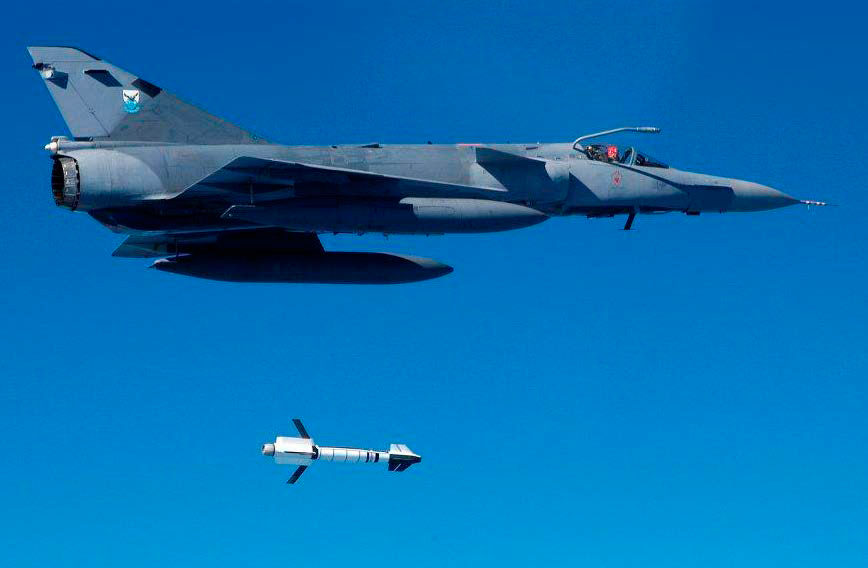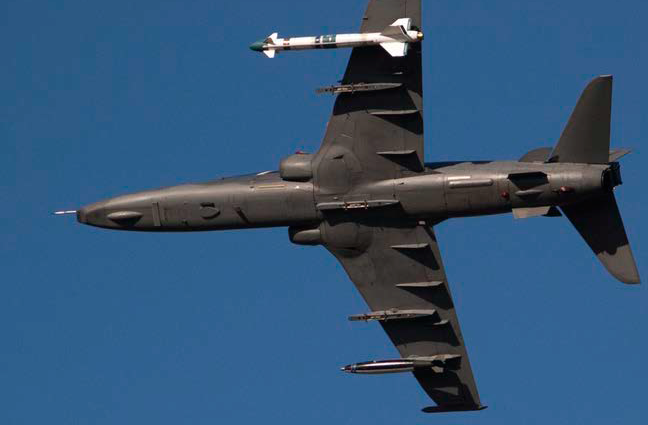France’s Armement Air-Sol Modulaire (AASM) ‘Hammer’ modular precision-guided bomb kit is an impressive weapon, without any doubt one of the best of its kind in service anywhere in the world.
It stands out in a crowded field by virtue of its flexibility, being able to fit on everything from lightweight 125 kg Mk81-style bombs all the way through to mammoth 1 000 kg Mk84- style bombs, while having up to 70 km of stand-off range thanks to a built-in rocket booster, and all with a sub-1 metre circular error probability (CEP) accuracy.
The French Air Force and Navy have operated the AASM for nearly fifteen years, with excellent operational results reported from theatres like Libya and Mali. They’re so satisfied with the kit that it has become the mainstay precision-guided munition for both forces. And it has now been exported to the Moroccan, Egyptian, Qatari, and Indian Air Forces.
By all measures the AASM is a successful programme. Yet few people know that it wasn’t actually developed in France, but in South Africa, by the then-Kentron (now Denel Dynamics) under Project Green.

In 2000, Sagem won the French government contract to develop what would become the AASM, but lacked some in-house expertise in the aerodynamics and systems engineering of precision-guided munitions. Given the intense time pressure of the contract, Sagem decided to look for a company with ready-made experience to which it could outsource the initial development and testing work. It chose Denel, apparently because of the company’s proven success with the H2 and H4 stand-off weapons, which were exported as the Raptor I and Raptor II respectively to countries like Pakistan, along with its other weapons like the MUPSOW and TORGOS long-range stand-off weapons. Importantly, the H4 was fitted with a rocket motor to boost its stand-off distance and both the H2 and H4 already incorporated hybrid GNSS/INS guidance for accuracy to around a 10 m CEP as well as an imaging-infrared (IIR) sensor with target recognition to bring that down to around 1 m.
Even with that experience Project Green was a difficult undertaking for Kentron, with a tight deadline of less than four years between the contract awarding date and the expected date of delivery in 2004, and strict acceptance criteria. Moreover, the required modularity of the design presented its own unique problems that the team had never before encountered.
Nonetheless Denel succeeded despite a few hiccups and the first launch tests, from a South African Air Force (SAAF) Cheetah C at the Test Flight and Development Centre (TFDC) at AFB Overberg, kicked off in September 2004. By June 2005 France’s Délégation générale pour l’armement (DGA) was able to carry out the first launches from a Mirage 2000 at its test site in Biscarosse. Sagem took over the rest of the development programme and Project Green came to an end, with all of Denel prevented by the terms of its contract from ever revealing its role in the project.
However, the experience that Denel’s engineers gained on the AASM project convinced both the SAAF and Denel to transfer those lessons into a new product, and so the team soon went to work on what would become the Umbani precision-guided munitions kit with technology development funding from the SAAF under Project Katleho.
Like the AASM, Umbani was designed to be modular so as to allow it to fit a wide range of bomb sizes, have multiple guidance and seeker options, and have optional range extension. But unlike the AASM, which opted for only fin-based control, the Umbani was to have a pair of optional folding wings that extended the stand-off range to 120 km without rocket boosting, and up to 200 km with a rocket booster fitted.
The SAAF’s initial Project Katleho development funding took the Umbani to live subsonic launch tests from a Cheetah at TFDC, then a Mirage F1, and finally a SAAF Hawk Mk120, but was insufficient for supersonic integration on the Gripen or acquisition into SAAF service.
With that funding coming to an end, Denel looked elsewhere for customers and partners. It found the United Arab Emirates’ Tawazun, a rapidly growing state-controlled defence firm looking to acquire projects and technology from elsewhere to build up their local defence industry. Denel and Tawazun formed a joint venture company around Umbani, soon renamed ‘Al-Tariq’, called Tawazun Dynamics and set about integrating the weapons system on United Arab Emirates Air Force (UAEAF) Hawks and Mirage 2000s under Project MBARC. That joint venture still exists today, and the Al-Tariq is in active service with the UAEAF.
‘serious doubts as to whether Denel Dynamics can even be saved’
Project Green, and to a lesser extent Umbani after the Al-Tariq joint venture was formed, are examples of ‘white label’ weapons development, where companies are contracted to anonymously design and develop new products on behalf of other companies which then market and sell it as their own. It was also not the first or only time that Denel and its subsidiaries have quietly engaged in white label development: Over the years it became a fairly substantial portion of the company’s business.
Amongst the many projects and products that Denel, in particular Denel Dynamics, worked on are the P2, P3, P4, and Sejeel precision guided munitions projects for EDGE, the Saqr armed drone for Saudi Arabia’s King Abdulaziz City for Science and Technology (KACST), Pakistan’s Ra’ad cruise missile programme, and many others.
Denel Spaceteq even designed and launched at least three satellites for Saudi Arabia: SaudiSat-3 in 2007 and SaudiSat-5a and -5b in 2018.
Nor is this limited to Denel, but over time has become almost standard practice for many parts of the South African defence industry which have tried to offset the rapid shrinking of local orders from the South African National Defence Force with similar white label developments and technology transfers with mostly Middle Eastern countries going through industrialisation drives. One recent example is the RW24 smart loitering munition recently unveiled by the EDGE subsidiary ADASI, which bears an uncanny resemblance to Paramount Advanced Technology’s RoadRunner drone. There are many others.
However, while this sort of white labelled development has undoubtedly been profitable, it is not without risks and downsides. First amongst them is that it’s a practice with a finite lifespan: While it works well at first, when one or more countries or companies are building up their own skills in an area, before long that demand comes to an end and the opportunities cease. Worse, you have now created a competitor, and introduced that competitor to your key engineering staff who they can poach as soon as the contract is over. Second, it can become too easy to rely on this source of revenue rather than further developing and enhancing the production capabilities and marketing of your own products, leaving you in a bad place when the white label development orders dry up. Third, it’s bad from a cash flow perspective as it creates a feast or famine situation, even more so than the uneven cash flow that comes from typical weapons system sales.
By all indications, all of these risks hit Denel Dynamics hard, along with other factors such as State Capture-related corruption and deep cuts in SANDF acquisition funding, and have been a substantial contributor to its current extremely dire state.
While it had a few years of plenty, as it helped to design and develop entire families of products for companies like EDGE, SAMI, and KACST, it was unprepared for how swiftly that dried up once those companies developed a sufficient level of local capability to continue on their own.
‘Middle Eastern companies have poached dozens of key Denel staff’
Those Middle Eastern companies have also poached dozens of key Denel engineering staff, some with decades of experience. Most of the other remaining key engineering staff, especially at Denel Dynamics, have left for companies like Incomar which perform substantial work on behalf of companies like EDGE in any case. One can hardly blame them, given that Denel’s cash crisis has meant that none have received full salaries for nearly two years.

Emblematic of this process is the recent unveiling by EDGE of their SkyKnight C-RAM missile defence system developed in co-ordination with Rheinmetall, which is extremely similar to the Cheetah C-RAM system which Denel Dynamics had previously developed with Rheinmetall for the exact same purpose and role. Virtually the entire Cheetah C-RAM team left Denel Dynamics in the past two years and at least some have been confirmed to have worked on SkyKnight.
To be clear, both Rheinmetall and EDGE, as well as the engineers involved, are insistent on stating that the SkyKnight missile differs from the Cheetah and that it should not be seen as an unauthorised copy. It is certainly slightly larger and differs in other significant ways, but it’s difficult to not reach the conclusion that it’s at the very least a continuation of the Cheetah C-RAM project in spirit, with many of the same people, but outside of Denel and without Denel being able to benefit from it.
Given the level of skills loss, there are now serious doubts as to whether Denel Dynamics can even be saved at this point. So many key people have left, so many capabilities and divisions now left unstaffed, that it may be impossible to rebuild.
Amongst the affected projects is the A-Darter, which Denel Dynamics is meant to be building at scale for the SAAF (under Project Kamas) and the Brazilian Air Force, but which is years behind schedule and now potentially postponed indefinitely. There have been rumours that Incomar, Hensoldt, and other companies have been in discussions to take over the A-Darter production contract but none have the requisite in-house infrastructure, the data packs, or enough of the expertise to do it alone.
It’s sad to believe that, quite soon, Denel Dynamics and its illustrious history might be no more. It’s also disappointing that much of what it developed over the years, projects just like the AASM, the various SaudiSats, and Saqr, will likely never be known about as they were developed under confidential white label terms. This piece is an attempt to lift the lid on at least part of that history.


